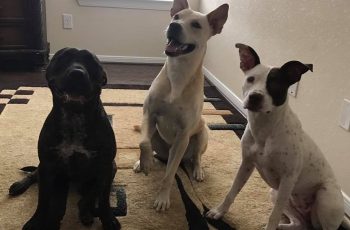Does your dog come to you when called? Does your dog run out the door as soon as you open it? Trust me. You’re not alone. It’s happened to all of us, and it can be tough during a dog’s rebellious adolescent stage.
If you want to train your dog and improve your dog recall, read on. These 20 simple tips will help with your training and improve your dog’s recall.
Tips to Improve Your Dogs Recall
1. Make it fun.
The first step to training any behavior is to make it fun for the dog. Be enthusiastic when calling and reward them with something they love when they get there. If you call your dog and then scold him when he arrives, you’re going to confuse him, and the behavior will not improve. Always offer high-value rewards for desired behavior!
2. Change your tone of voice.
If you’ve been using one tone for years on end to call your dog, try changing it up a bit. Remember there are lots of different sounds in the English dictionary, try some new ones. Dogs are smarter than you think. They start to figure things out when they hear the same thing over and over again. If you use inconsistent tones, he might be unsure what exactly you want from him.
3. Make sure dinner time isn’t just an excuse to eat.
When you feed your dog, spend a little time with him afterward. Be sure to keep him close and offer a few training sessions while he’s still excited about dinner. Use his high energy after eating as motivation for training.
4. Make sure all members of the pack are on the same page.
Be consistent whenever you practice your recall in front of other family members, especially kids. If he’s off-leash and misbehaves, keep him off-leash for a while and use a long line when you offer commands. Make sure other family members know what you’re doing so they can help enforce it.
5. Take him with you.
Take your dog with you wherever you can. If you enjoy taking walks, take him with you when you go. If your kids have ball practice after school, bring him. Have your dog join in wherever possible to make his world bigger and increase the likelihood that he’ll want to be part of the action!
6. Learn to play fetch.
Besides improving his recall, playing fetch can be a great way to get him excited about returning. It’s a pretty cool game too, once you’ve mastered it, you can play it with your dog in the backyard on any occasion!
7. Make him an official pack member.
The next step is to make your dog an official pack member. He may not understand the hierarchy of being a big dog, but he will understand that all other dogs will listen to you and follow your lead. Use your dogs’ name often and let him know that it’s his privilege to be with you.
8. Use an electronic collar.
If you have tried everything and are still having problems with your dog coming when called, you may need to buy an electric fence collar. These collars provide a small shock when the dog approaches the boundary of your yard. Make sure you are using a collar that will not harm your pet when used at its maximum setting for training (for most, the “stimulation” setting is enough). Keep in mind that this type of training should be used as a last resort.
9. Say One Command Only & Only For Recall.
You want to get away from confusing your dog when you’re calling him. Don’t call your dog and say “sit,” “stay,” “come,” etc., because that can be confusing to your dog, and he may not know how to respond the next time when you use them in a different context; like “down.” Instead, make sure that you choose one command and use it for recall only.
Be Consistent With Your Recall Command. However, use the same word or phrase every time you want to recall your dog.
10. Use your recall command.
Daily, practice recalling your dog by using your recall command (i.e., “Coco, Come”) in different locations and various situations. Make sure he responds well when you call him from another room or across a field and that he is returning quickly and obeying any directional commands you give along the way.
If you call your dog and he comes all the way home only to get yelled at for ruining your carpet, he’s going to stop listening to your commands. Make sure that you regularly call him into the house, but then give him a treat when he arrives so that he knows it’s okay to come back in.
11. Reward your dog with a treat whenever he comes when called.
There are a lot of different ways to reward a dog for coming to you when called. I like to use “treats” because they can be easily administered and work in most situations. If you want to get specific with your dog, use the command word or phrase when you give him his treat and wait for him to respond correctly before giving him any other treat.
12.Repetition
Training your dog to come when called will need to be repeated consistently over his lifetime. You will have great success at first, but your dog may forget as time goes on. It’s important to repeat yourself and stay consistent with the training techniques outlined above so that he can continue to respond to the recall command accurately. Remember that dogs are creatures of habit, and with good training habits, he won’t forget the steps you have taught him.
13. Don’t Punish Your Dog When They Fail To Come When Called.
It is important to note that it is okay if your dog does not come back for the first few times you call him. This is natural, and it’s the reason why you should practice calling him every day. Nevertheless, when he comes and does not obey your commands or does not respond properly, do not punish him. Use your leash to walk him back home or correct his posture socially, even though these are negative reinforcements.
14. Stop Training When Your Dog Loses Interest.
It’s essential to recognize that your dog will lose interest in training at some point. When this happens, stop and try again later when he is more enthusiastic about training. Just like with humans, losing interest can be a part of the learning process. When you teach your dog to come when called, he might lose interest for a few days or hours but will likely be back to it very soon.
15. Don’t Assume Your Puppy is Too Young to Learn.
It’s very common for people to assume that puppies are too young to learn. This is a big mistake, and it’s why you should start training them as early as possible. As a puppy grows into an adult dog, he will get more stubborn and harder to teach, and this is something you want to avoid at all costs.
16.Make the Release its Reward.
Dogs love to explore. This is their primary purpose and what they are best at. By marking your territory, you can create a learning process that will teach them that the release of the collar is a good reward for them to work for it by exploring.
17.Be Consistent.
After you’ve corrected your dog for marking, don’t give up on training. You need to be consistent with your training techniques so that eventually, they will stick! Don’t just stop one day when it seems like all of your progress has been lost because you may lose the motivation to continue training if you don’t have a daily routine to follow.
Consistency is vital when it comes to these methods. If you stop practicing these techniques for a while, your dog will eventually forget what he learned. Ensure you practice at least once every day and keep doing it consistently throughout the dog’s lifetime.
18. Be Patient.
It takes a while for your dog to learn what his collar means. They may not understand the concept of marking until they are one to two years old. Even then, it takes them some time to think about it and be motivated enough to want to do something about it. Many dogs will never really get motivated by these methods, but they are good for most dogs in the beginning.
19. Don’t Underestimate the Power of a Good Collar.
If you’re not using an electronic collar for training, it is still important to have a collar on your dog when you call him. This allows you to quickly reel your dog in if he decides to get distracted and ignore your commands completely.
20. Don’t be focused on the Collar.
Remember to focus on the release device (e.g., your hand, a long line, a friend, etc.) when you are training and not the collar itself. As soon as he understands that he can be released from his collar if he comes back home and does not mark, you should begin using the collar for recall only.
To conclude, remember that training your dog is a long process and will take some time. If you stick with it, you will be glad that you did!


